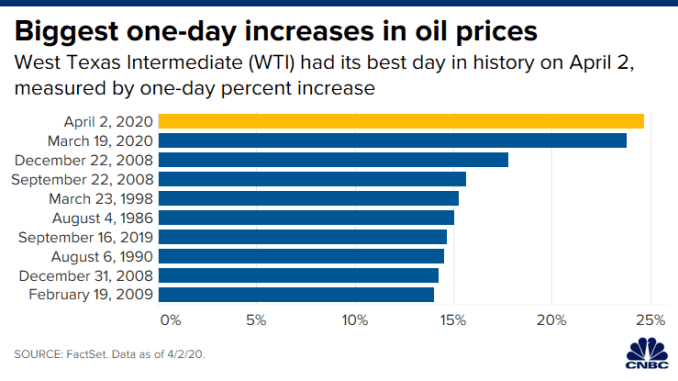Oil prices surged again on Friday on the hope that a production cut deal will soon be reached after OPEC and its allies announced they will hold a virtual meeting on Monday, and after Russian President Vladimir Putin reportedly said that the county wanted to see global action on cuts of around 10 million barrels per day.

Source: CNBC
U.S. West Texas Intermediate crude jumped 8.6%, or $2.17, to trade at $27.52 per barrel. At the session high, WTI gained more than 12% to trade at $28.56. WTI is up more than 20% for the week, and is on track to snap a five-week losing streak. International benchmark Brent crude rose 13% to trade at $33.87 per barrel.
“In our view there is no OPEC+ choice involved, the rhetoric is window-dressing, the market will deliver cuts, and they will be deeper than any OPEC+ agreements,” Mizuho managing director Paul Sankey said in a note to clients Friday.
On Thursday WTI and Brent posted their best day on record after President Donald Trump told CNBC that he expected Russian President Vladimir Putin and Saudi Crown Prince Mohammed bin Salman to announce a deal to cut oil production by 10 million to 15 million barrels, although the exact details of the cut remained unclear.
WTI gained 24.67% to settle at $25.32, while Brent rose 21% to settle at $29.94.

But some have questioned whether a cut of the magnitude Trump is suggesting is possible, especially if the U.S. doesn’t participate. According to a report from Reuters, the administration does not intend to ask U.S. companies to scale back production.
Texas Railroad Commissioner Ryan Sitton said that the state would potentially agree to curb production in an effort to prop up prices.
“This will be part of a singular deal. We’re following the President’s lead on this … If this is part of that international agreement, in light of the fact that we are in arguably the worst economic pandemic in mankind’s history, then we will participate in extraordinary measures due to those extraordinary circumstances,” Sitton said Friday on CNBC’s “The Exchange.”
Outlining what could possibly come next, Eurasia Group’s Ayham Kamel said the most likely path forward is a “large OPEC+ supply cut that is complimented by a U.S. cut.” Alternatively, he noted that talks could conclude with no deal. The least likely outcome of all is OPEC+ cuts without some form of U.S. participation.
“Even if OPEC+ producers reach such an agreement [without participation from the U.S.], the volume of cuts would be much more limited and below 10 million barrels per day,” Kamel wrote in a note to clients.
Despite Thursday’s jump, WTI is still down more than 40% during the last month.
Demand has evaporated as the coronavirus outbreak has halted travel worldwide and slowed business activity, just as a price war broke out between powerhouse producers Saudi Arabia and Russia.
In March OPEC de facto leader Saudi Arabia recommended cutting production by 1.5 million barrels per day as the pandemic slowed demand. But OPEC ally Russia rejected the proposal, sparking the price war.

On Wednesday Saudi Arabia ramped up its production to a record high of more than 12 million barrels per day, after previous OPEC+ production cuts expired at the end of March.
As oil prices cratered — WTI is coming off its worst month and quarter in history — the U.S. sought to intervene.
U.S. producers have been among the hardest hit as companies struggle to break even with depressed oil prices. On Wednesday, Whiting Petroleum became the first major U.S. shale producer to declare bankruptcy. On Friday, executives from at least seven U.S. energy giants including Exxon and Chevron will meet with Trump at the White House to discuss energy policy.
But even if a deal is reached, many argue that prices could fall back into negative territory due to the unprecedented demand destruction caused by the coronavirus. In other words, the supply side is a secondary story to the demand hit.
“The energy sector is facing its most challenging fundamental period since the Great Energy Depression of 1981-1995,” RBC’s co-head of global energy research Kurt Hallead said. “On the oil front, demand is set to decline by amounts never before seen driven by the COVID-19 global economic shock while supply is surging due to the Saudi-Russia oil price war,” he added.

